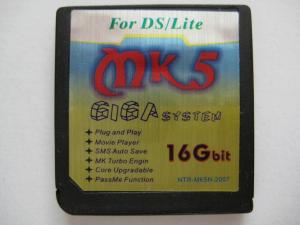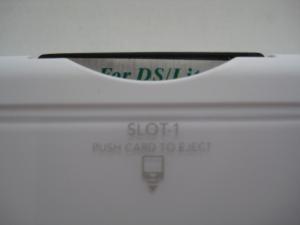Special thanks to:

For providing the MK5 GIGA for this review.
– Introduction –
Early on the slot 1 wars, a cart by the name of N-Card was released. Soon after, the whole market was bombarded by carts that are extremely similar to the N-Card. These carts include the MK5 GIGA, the DS Linker, the DS Key, the Ultra Flash Pass EX, the Express Card, etc. The DS Linker has already previously reviewed at DS Database over here. However, unlike other sites, we will not copy and paste the same review twice because we recognize that there are differences between N-Card clones, as well, this review will also reflect very important updates that have occurred in between the times of these reviews.
The MK5 GIGA cart is the Neoflash team’s version of the N-Card. Looking very similar, the MK5 GIGA does differ from other N-Card clones as it has its own forum, uses its own firmware, even the build quality to unique to its own.
The N-Card clones in general have not received too much attention as they were passed up as terrible and slow. However, lately there has been more attention on this cart because of the extremely cheap prices, and the great reviews it has been receiving. At about $40 USD, you can purchase a 2GB (advertised as 16Gbit) MK5 GIGA at various places, beating competitors by almost half. With updates that can be interchanged among various N-Card clones, it seems great to have so many options.
The Neoflash team has been known to have some amazing carts, although not solid, always revolutionary. They had the first stable NDS flash cart, they have been mixed into interesting passcards, and at this point, they are even integrating motion sensors into their flash carts. Even though pass flash carts of the Neoflash team have not been so great, the MK5 GIGA seems to stand up to competitors.
– Design –
The review unit of the MK5 GIGA I received was the 2GB (16Gbit) model. Unfortunately, as per Bamboogaming.com shipping policy, I did not receive any packaging. However, that is not a big deal, the main focus of a flash cart is its usability, and not the packaging.
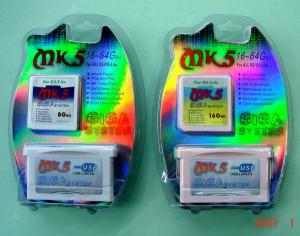
If you are interested in how the packaging looks, the above picture was found on www.Neoflash.com.
Fortunately, I did receive all the components to the MK5 GIGA, which includes the MK5 GIGA, the slot-2 writer, a USB cable, and a disk with hugely outdated software. The USB cable seems very nice, the cable was nice and thick, the USB portion was very study. I thought that the cable’s quality was far superior than the DS Linker’s supplied cable. Unfortunately, I have not been able to track down all the other N-Card clones, but the MK5 GIGA’s USB cable is definitely sturdier, and perhaps even faster than the DS Linker’s. As mentioned before, the CD included with the MK5 GIGA bundle contained useless software and outdated firmware. It is far better to fetch the firmware and option software and applications from their official site, which I believe is noted on the packaging at www.Neoflash.com.
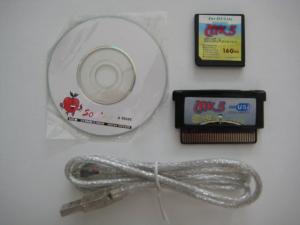
There aren’t any freebies, but it really doesn’t matter.
The Slot-2 writer is an object unique to all N-Card clones. It is plugged into the slot 2 of a Nintendo DS or DS Lite, and has a small port that allows it to be connected to the computer with the supplied USB cable. The MK5 GIGA slot-2 writer once again seems to be sturdier than the one supplied with the DS Linker. It is made of high quality plastic, and the port is nice and tight. Unfortunately, it follows the Neoflash style for older GBA cartridges, where the bottom quarter of the case is missing. Perhaps they wanted to save a few pennies on the plastic. In the end, plugging it into the DS is a bit harder because of the missing part of the case, however, it is still quite easy to do, and there aren’t any problems or issues caused by this design. Overall, the slot-2 writer is great, the plastic is very solid. It is GBA sized, so it will stick out of the Nintendo DS Lite, however, the slot-2 writer is only used for importing games into the MK5 GIGA cart, and not for actual gameplay.
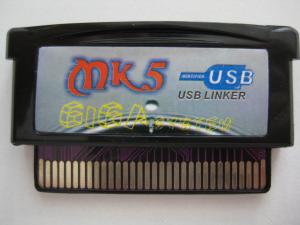
Who’s bright idea was it to loose some of the case?
The MK5 GIGA cart has a very nice shiny sticker on the front. It looks great, almost as if it was made of thin metal. However, it is just a sticker. However, the design looks great, and the look of the letters “For DS/Lite” peeking out of the DS Lite when inserted is amazing. The actual case for the MK5 GIGA is black, not grey, which makes it look different from an actual game cartridge. But the case matches the Onyx Black DS Lite very well, and the bit of the silver sticker sticking out makes it looks all the more impressive. The build quality for this cart is also great, it seems very study and tough, the plastic is very thoroughly black all the way through, and overall the build quality for this cart seems sturdier and stronger than any other cart I have seen, far superior to the DS Linker I have received.
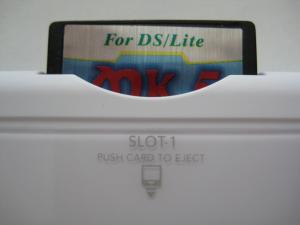
This cart looks amazing, I love the sticker!
Interestingly enough, the MK5 GIGA has a slight lump into the cart. Where normally chips stick out of a flash cart, the MK5 GIGA sinks in. It is very awkward to see that the cart actually has a hole instead of a chip sticking out. Either way, this does not cause any issues inserting the cart into a DS Lite. In fact, the cart slides in really nice and smooth, perhaps almost like an original if not the same.
– Software –
The MK5 GIGA is yet another “drag and drop” flash cart. Users simply take a file, and drop it in, whether it is firmware, games, or even homebrew. There is no software that you need to use.
To use the drag and drop features of the MK5 GIGA, you must first connect the cart to the computer. This is done by placing the MK5 GIGA cart into the DS, as well as the slot-2 writer. With those in place, you use the USB cable to connect the slot-2 writer to a computer’s USB port. At this point, you must turn on your DS, choose the MK5 GIGA, and select USB mode, the computer will then recognize the flash cart as a removable mass-storage device.
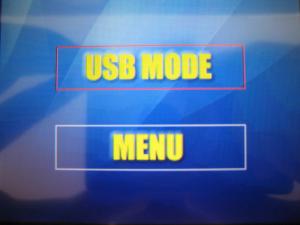
You can still access the game menu when you have your DS tied down to a USB port.
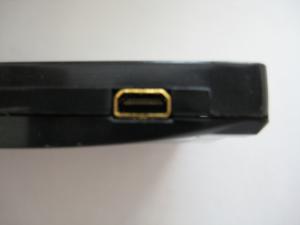
Use the tiny USB port on the slot 2 cart to connect the MK5 GIGA to the computer.
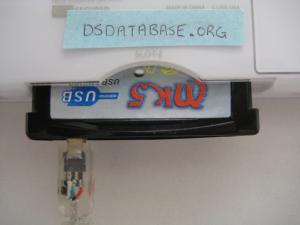
Looks like this when it is connected. The other side, obviously is just a standard USB port.
There are many complaints about the N-Card, and one of the main reasons users choose to avoid this cart is because of the incredibly slow write time. This remains true with the MK5 GIGA, it takes about 2 minutes to transfer a 128MB rom to the cart. It is bearable, but slow compared to other carts on the market.
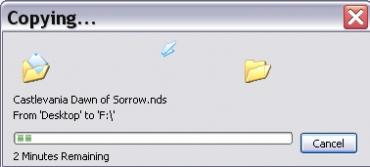
It isn’t so bad, but then again, when you have 2GB to transfer into the cart, it could take awhile.
As mentioned in many reviews, the N-Card clones all have interchangeable firmware, they can be swapped back and forth, so if one team fails to deliver, you can simply use some other firmware provided by another team. This is possible on the MK5 GIGA cart, however for the purpose of this review, I am using the MK5 GIGA’s own firmware. Note that all the different versions of the firmware are fairly similar other than perhaps the logo of the cart and some graphic designs. However, during updates, most N-Card clones must do a full format, however, the DS Linker’s firmware does not.

The DS Linker firmware works fine on the MK5 GIGA.
– Use –
Here is a quick demo of the MK5 GIGA’s menu.
The DS Lite boots into the DS menu, and allows you to select the MK5 GIGA cart. Although some may consider this a drag, I like to see the DS menu to choose GBA games or download play sometimes. If it is a big problem, you can set your DS Lite to boot the DS game right away through the options, which allows the MK5 GIGA to boot right away.
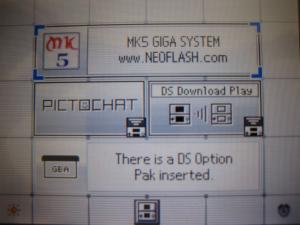
It is nice to see the DS menu if you have accessories like the EZ Flash 3 in 1.
When run the MK5 GIGA, it shows some text, backing up the previous save files, and loading the menu. After about a second or two, you see a brilliant menu, basically a list of 5 games at a time and a very intuitive scroll bar. Unfortunately the menu doesn’t allow any extra options except changing save types (by holding selecting and moving left and right). As a result, all of the extra features such as passme and Moonshell are done via files on the MK5.
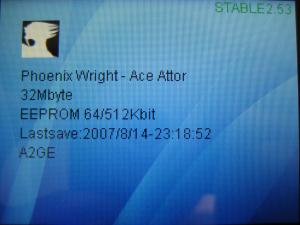
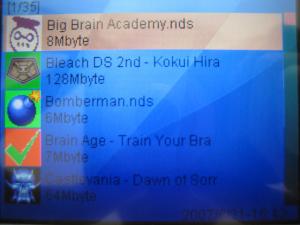
The menu looks brilliant if you find the right skins. Currently it looks pretty bland, but functional.
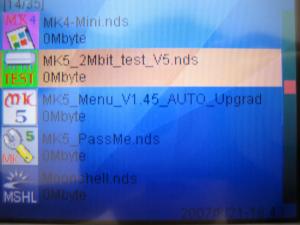
Sometimes you just get angry at how some of these files plague your list.
When a game is selected, it is quite simple, it loads the save in a split second then runs the game. In game, you can reset out by clicking L+R+A+B+X+Y, but in my tests, I found that some games don’t work properly.
– Functionality –
Probably what made the N-Card clones and the MK5 GIGA well known is its amazing compatibility and superb speed. With later updates, this is still true. The MK5 GIGA runs all commercial games without a problem. Sometimes it does require switching back and forth to check which save type to use, but the automatic settings are generally very accurate, in fact I have only had it fail me once. The speed of all the games this cart runs is at full speed, there is no lag on Castlevania: Dawn of Sorrow or Castlevania: Portrait of Ruin.
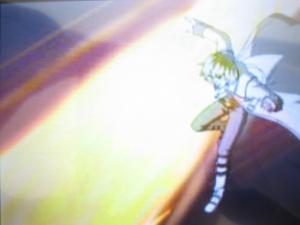
Castlevania – Dawn of Sorrow’s intro runs flawlessly!
Early on, the MK5 GIGA did not support download play, however, the recent patches boast fixes on a large amount of download play games. I have personally tested a few roms, and it is certainly an improvement from the zero download play support previously sported by this cart. In terms of download play, it beats even the G6DS Real during launch. Here are my results:
DOWNLOAD PLAY TESTS
Working (Download Play)
Tetris DS
Mario Kart DS
New Super Mario Bros.
Bomberman Land Touch
Bomberman
Elite Beat Agents
Meteos
Quickspot
True Swing Golf
Super Mario 64 DS
Mario Hoops 3 on 3
Nanostray
Brain Age: Train Your Brain in Minutes a Day!
Winning Eleven Pro Evolution Soccer DS
Not Working (Download Play)
Club House Games
Big Brain Academy
Homebrew is all the rave at this point, with great applications such as DSHoBro and DSOrganize, and emulators like nesDS and snesDS, it is no surprise that users want the best support possible. The MK5 GIGA does not disappoint, it obviously has a DLDI patch, but to take it one step further, it automatically patches homebrew when you run it from the cart. There is no need to manually patch files anymore with the MK5 GIGA. As DLDI is now the standard for all homebrew, it is pretty much all a user can ask for in terms of homebrew support.
– Conclusion –
The MK5 GIGA is a great cart. It seems to be an affordable option with great features. The cart comes in both 1GB (advertised as 8Gbit) or 2GB (advertised as 16Gbit), The 1GB version can be found at about $30 USD while the 2GB version clocks in at $40 UDS. For the extra $10, I highly recommend the 2GB version because the extra 1GB memory is very useful in a tight spot, and with such great features, there is no doubt that you will be using this cart a lot.
In terms of the cart, the MK5 GIGA has very high build quality, and the cart slides into the DS Lite very easily. Without a MicroSD slot, it could almost be mistaken for a genuine cartridge. The cart features great compatibility for both NDS games and homebrew while offering high download play support and zero lag. It has a nice looking menu that functions very well, and best of all, the MK5 GIGA is the cheapest cart on the market.
However, the MK5 GIGA does have a crippling flaw. It uses a slot-2 writer to connect to the computer which gives incredibly slow transfer speeds. It is annoying to transfer large amounts of games between the computer and the flash cart. This alone can turn users away.
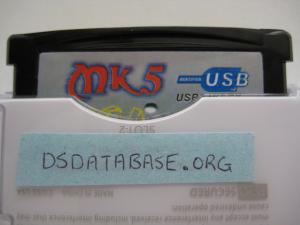
Seems like an interesting idea to use slot 2 of the DS Lite to store a writer.

Didn’t work out too well though…
In conclusion, the MK5 GIGA is a worthwhile choice, it is easy to use, has great features, and is a solid product. The build quality of the cart is far superior to another N-Card clone called the DS Linker, and it is backed up by a well known team, the Neoflash team. It seems like an obvious choice if you are looking to get a flash cart as cheaply as possible.
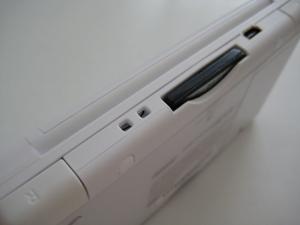
Definitely consider this cart, it is cheap and functional, what else can you ask for?
– Score –
Design – 5/5
Software – 5/5
Use – 4/5
Functionality – 18/20
Tilt – 5/5
Overall – 37/40
